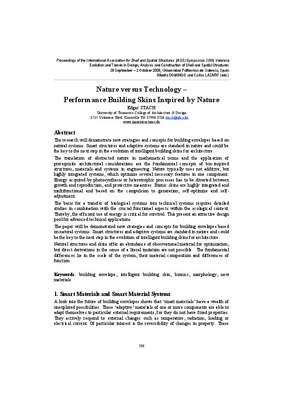JavaScript is disabled for your browser. Some features of this site may not work without it.
Buscar en RiuNet
Listar
Mi cuenta
Estadísticas
Ayuda RiuNet
Admin. UPV
Nature versus Technology - Performance building skins inspired by nature
Mostrar el registro sencillo del ítem
Ficheros en el ítem
| dc.contributor.author | STACH, Edgar
|
|
| dc.contributor.editor | Domingo Cabo, Alberto
|
es_ES |
| dc.contributor.editor | Lázaro Fernández, Carlos Manuel
|
es_ES |
| dc.date.accessioned | 2010-01-08T13:07:22Z | |
| dc.date.available | 2010-01-08T13:07:22Z | |
| dc.date.issued | 2010-01-08T13:07:22Z | |
| dc.identifier.isbn | 978-84-8363-461-5 | |
| dc.identifier.uri | http://hdl.handle.net/10251/6845 | |
| dc.description | p. 598-610 | en_EN |
| dc.description.abstract | The research will demonstrate new strategies and concepts for building envelopes based on natural systems. Smart structures and adaptive systems are standard in nature and could be the key to the next step in the evolution of intelligent building skins for architecture. The translation of abstracted nature in mathematical terms and the application of prerequisite architectural considerations are the fundamental concepts of bio-inspired structures, materials and systems in engineering. Nature typically uses not additive, but highly integrated systems, which optimize several necessary features in one component. Energy acquired by photosynthesis or heterotrophic processes has to be diverted between growth and reproduction, and protective measures. Bionic skins are highly integrated and multifunctional and based on the compulsion to generation, self-optimize and selfadjustment. The basis for a transfer of biological systems into technical systems requires detailed studies in combination with the crucial functional aspects within the ecological context. Thereby, the efficient use of energy is critical for survival. This present an attractive design pool for advanced technical applications. The paper will be demonstrated new strategies and concepts for building envelopes based on natural systems. Smart structures and adaptive systems are standard in nature and could be the key to the next step in the evolution of intelligent building skins for architecture. Natural structures and skins offer an abundance of observational material for optimization, but direct derivations in the sense of a literal imitation are not possible. The fundamental differences. | en_EN |
| dc.language | Inglés | en_EN |
| dc.publisher | Editorial Universitat Politècnica de València | es_ES |
| dc.relation.ispartof | Symposium of the International Association for Shell and Spatial Structures (50th. 2009. Valencia). Evolution and Trends in Design, Analysis and Construction of Shell and Spatial Structures : Proceedings | en_EN |
| dc.rights | Reserva de todos los derechos | en_EN |
| dc.subject | Building envelope | en_EN |
| dc.subject | Intelligent building skin | en_EN |
| dc.subject | Bionics | en_EN |
| dc.subject | Morphology | en_EN |
| dc.subject | New materials | en_EN |
| dc.title | Nature versus Technology - Performance building skins inspired by nature | en_EN |
| dc.type | Comunicación en congreso | en_EN |
| dc.rights.accessRights | Abierto | es_ES |
| dc.description.bibliographicCitation | Stach, E. (2010). Nature versus Technology - Performance building skins inspired by nature. Editorial Universitat Politècnica de València. http://hdl.handle.net/10251/6845 | es_ES |
| dc.relation.conferencename | Symposium of the International Association for Shell and Spatial Structures | es_ES |
| dc.relation.conferencedate | 2009 | es_ES |
| dc.relation.conferenceplace | Valencia | es_ES |






